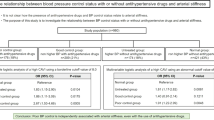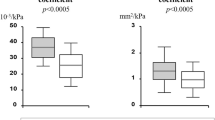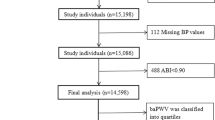Abstract
Although lowering blood pressure (BP) reduces aortic stiffness, achieving the recommended BP goal can be difficult. Recent studies have shown that short-term use of statins can reduce BP significantly. To determine the long-term effects of statins on BP and aortic stiffness, a single-blind randomized prospective study was performed on 85 hyperlipidaemic hypertensive patients whose BP was insufficiently controlled by antihypertensive therapy. Every 3 months, aortic stiffness was assessed by measuring pulse wave velocity (PWV). Patients were randomly allocated to groups treated with pravastatin, simvastatin, fluvastatin, or a nonstatin antihyperlipidaemic drug. No significant differences in patient characteristics, kinds of antihypertensive drugs, BP, ankle brachial index, PWV, or serum lipid, creatinine, or C-reactive protein levels were found between the four groups at the start of the study. During the 12-month treatment period, PWV did not change in the pravastatin group or nonstatin group, but it was transiently reduced in the simvastatin group and significantly decreased in the fluvastatin group, even though the doses of the statins used in this study were lower than the usually prescribed dose. All four antihyperlipidaemic drugs significantly decreased serum cholesterol levels without affecting BP, ankle brachial index, or serum triglyceride levels. The C-reactive protein serum levels decreased significantly in the three statin groups but not in the nonstatin group. These results suggest that long-term use of fluvastatin by hyperlipidaemic hypertensive patients is associated with a significant reduction in aortic stiffness without any effect on BP.
This is a preview of subscription content, access via your institution
Access options
Subscribe to this journal
Receive 12 digital issues and online access to articles
$119.00 per year
only $9.92 per issue
Buy this article
- Purchase on Springer Link
- Instant access to full article PDF
Prices may be subject to local taxes which are calculated during checkout




Similar content being viewed by others
References
Blacher J et al. Aortic pulse wave velocity as a marker of cardiovascular risk in hypertensive patients. Hypertension 1999; 33: 1111–1117.
Laurent S et al. Aortic stiffness is an independent predictor of all-cause and cardiovascular mortality in hypertensive patients. Hypertension 2001; 37: 1236–1241.
Asmar RG, London GM, O'Rourke ME, Safar ME . Improvement in blood pressure, arterial stiffness and wave reflections with a very-low-dose perindopril/indapamide combination in hypertensive patient. A comparison with atenolol. Hypertension 2001; 38: 922–926.
Boutouyrie P et al. Aortic stiffness is an independent predictor of primary coronary events in hypertensive patients. A longitudinal study. Hypertension 2002; 39: 10–15.
Ichihara A et al. Long-term effects of intensive blood-pressure lowering on arterial wall stiffness in hypertensive patients. Am J Hypertens 2003; 16: 959–965.
Glorioso N et al. Effect of the HMG-CoA reductase inhibitors on blood pressure in patients with essential hypertension and primary hypercholesterolemia. Hypertension 1999; 34: 1281–1286.
Spósito AC et al. Additional reduction in blood pressure after cholesterol-lowering treatment by statins (lovastatin or pravastatin) in hypercholesterolemic patients using angiotensin-converting enzyme inhibitors (enalapril or lisinopril). Am J Cardiol 1999; 83: 1497–1499.
Borghi C et al. Use of statins and blood pressure control in treated hypertensive patients with hypercholesterolemia. J Cardiovasc Pharmacol 2000; 35: 549–555.
Kaesemeyer WH, Caldwell RB, Huang J, Caldwell RW . Pravastatin sodium activates endothelial nitric oxide synthase independent of its cholesterol-lowering actions. J Am Coll Cardiol 1999; 33: 234–241.
Nickenig G et al. Statin-sensitive dysregulated AT1 receptor function and density in hypercholesterolemic men. Circulation 1999; 100: 2131–2134.
Wassmann S et al. HMG-CoA reductase inhibitors improve endothelial dysfunction in normocholesterolemic hypertension via reduced production of reactive oxygen species. Hypertension 2001; 37: 1450–1457.
Novaro GM et al. Effect of hydroxymethylglutaryl coenzyme A reductase inhibitors on the progression of calcific aortic stenosis. Circulation 2001; 104: 2205–2209.
Muramatsu J, Kobayashi A, Hasegawa N, Yokouchi S . Hemodynamic changes associated with reduction in total cholesterol by treatment with HMG-CoA reductase inhibitor pravastatin. Atherosclerosis 1997; 130: 179–182.
Ubels FL et al. Effects of initial and long-term lipid-lowering therapy on vascular wall characteristics. Atherosclerosis 2001; 154: 155–161.
Raison J, Rudnichi A, Safar ME . Effects of atorvastatin on aortic pulse wave velocity in patients with hypertension and hypercholesterolemia: a preliminary study. J Hum Hypertens 2002; 16: 705–710.
Fukumoto Y et al. Statins alter smooth muscle cell accumulation and collagen content in established atheroma of watanabe heritable hyperlipidemic rabbits. Circulation 2001; 103: 993–999.
Buemi M et al. Pro-apoptotic effect of fluvastatin on human smooth muscle cells. Eur J Pharmacol 1999; 370: 201–203.
Guijarro C et al. 3-Hydroxy-3-methylglutaryl coenzyme A reductase and isoprenylation inhibitors induce apoptosis of vascular smooth muscle cells in culture. Circ Res 1998; 83: 490–500.
Crisby M et al. Pravastatin treatment increases collagen content and decreases lipid content, inflammation, metalloproteinases, and cell death in human carotid plaques. Circulation 2001; 103: 926–933.
Ichihara A et al. Fluvastatin prevents development of arterial stiffness in hemodialysis patients with type 2 diabetes mellitus. Nephrol Dial Transplant 2002; 17: 1513–1517.
Sun K et al. The relation of pulse wave velocities measured by oscillometric and tonometric methods and clinical application studies. Jpn J Appl Physiol 2002; 32: 81–86.
Yamashina A et al. Validity, reproducibility, and clinical significance of noninvasive brachial-ankle pulse wave velocity measurement. Hypertens Res 2002; 25: 359–364.
Corsini A et al. Direct effects of statins on the vascular wall. J Cardiovasc Pharmacol 1998; 31: 773–778.
Bellosta S et al. Pleiotropic effects of statins in atherosclerosis and diabetes. Diabetes Care 2000; 23: B72–B78.
Guzik TJ et al. Vascular superoxide production by NAD(P)H oxidase: association with endothelial dysfunction and clinical risk factors. Circ Res 2000; 86: e85–e90.
Rikitake Y et al. Anti-oxidative properties of fluvastatin, an HMG-CoA reductase inhibitor, continue to prevention of atherosclerosis in cholesterol-fed rabbits. Atherosclerosis 2001; 154: 87–96.
Yamamoto A, Hoshi K, Ichihara K . Fluvastatin, an inhibitor of 3-hydroxy-3-methylglutaryl-CoA reductase, scavenges free redicals and inhibits lipid peroxidation in rat liver microsomes. Eur J Pharmacol 1998; 361: 143–149.
Imaeda A et al. Antioxidative effects of fluvastatin and its metabolites against DNA damage in streptozotocin-treated mice. Food Chem Toxicol 2002; 40: 1415–1422.
Suzumura K, Tanaka K, Yasuhara M, Narita H . Inhibitory effects of fluvastatin and its metabolites on hydrogen peroxide-induced oxidative destruction of hemin and low-density lipoprotein. Biol Pharm Bull 2000; 23: 873–878.
Imaeda A et al. Antioxidative effects of fluvastatin and its metabolites against oxidative DNA damage in mammalian cultured cells. Free Radic Res 2001; 35: 789–801.
Carneado J et al. Simvastatin improves endothelial function in spontaneously hypertensive rats through a superoxide dismutase mediated antioxidant effect. J Hypertens 2002; 20: 429–437.
März W et al. Fluvastatin lowers atherogenic dense low-density lipoproteins in postmenopausal women with the atherogenic lipoprotein phenotype. Circulation 2001; 103: 1942–1948.
Rossi E . C-reactive protein and progressive atherosclerosis. Lancet 2002; 360: 1436–1437.
Van-Der-Meer IM et al. C-reactive protein predicts progression of atherosclerosis measured at various sites in the arterial tree: the Rotterdam study. Stroke 2002; 33: 2750–2755.
Acknowledgements
This work was supported in part by grants from the Ministry of Education, Science and Culture, Japan (14571073) and from the Daiwa-Shoken Health Foundation (Tokyo, Japan). We thank Drs Munekazu Ryuzaki and Michiko Handa for their assistance at Kawasaki Ida Municipal Hospital and Ms Rika Wakita for her skillful secretarial work.
Author information
Authors and Affiliations
Corresponding author
Rights and permissions
About this article
Cite this article
Ichihara, A., Hayashi, M., Koura, Y. et al. Long-term effects of statins on arterial pressure and stiffness of hypertensives. J Hum Hypertens 19, 103–109 (2005). https://doi.org/10.1038/sj.jhh.1001786
Received:
Revised:
Accepted:
Published:
Issue Date:
DOI: https://doi.org/10.1038/sj.jhh.1001786
Keywords
This article is cited by
-
Associations of non-high-density lipoprotein cholesterol, triglycerides and the total cholesterol/HDL-c ratio with arterial stiffness independent of low-density lipoprotein cholesterol in a Chinese population
Hypertension Research (2019)
-
Apolipoprotein A1 mimetic peptide ATI-5261 reverses arterial stiffness at late pregnancy and early postpartum in a COMT−/− mouse model of preeclampsia
Clinical Hypertension (2018)
-
Future Treatment of Hypertension: Shifting the Focus from Blood Pressure Lowering to Arterial Stiffness Modulation?
Current Hypertension Reports (2015)
-
Inflammatory biomarkers CRP, MCP-1, serum amyloid alpha and interleukin-18 in patients with HTN and dyslipidemia: impact of diabetes mellitus on metabolic syndrome and the effect of statin therapy
Hypertension Research (2013)
-
Cardiovascular Calcifications in Old Age: Mechanisms and Clinical Implications
Current Translational Geriatrics and Experimental Gerontology Reports (2013)



